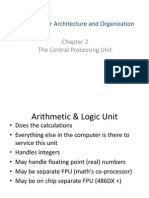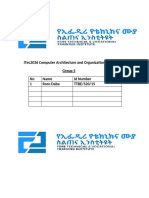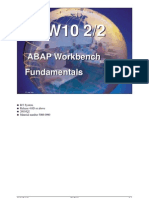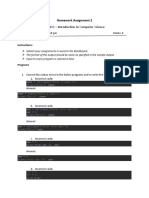Assignment com ar and org
Uploaded by
jk7872692Assignment com ar and org
Uploaded by
jk7872692Computer Architecture and organization Assignment No: 01
• Register transfer language:
Register Transfer Language (RTL) is a symbolic notation used to describe data transfers and
operations between registers in a computer system. It emphasizes how data moves within the
hardware, detailing the transfer of information from one register to another under the control of
specific signals. RTL plays a crucial role in designing and modeling the internal behavior of
digital circuits and systems.
• Arithmetic, logic and shift micro-operations:
Arithmetic: Operations like addition and subtraction between registers.
Logic: Bitwise operations (AND, OR, XOR, NOT) between register data.
Logic Micro-Operations involve performing bitwise operations like AND, OR, XOR, and
NOT on the contents of registers. These operations are essential for executing decision-making,
comparison, and control functions within a computer system.
• Binary data:
Binary data represents information using 0s and 1s, the fundamental building blocks of computer
data storage and processing due to binary logic systems.
Arithmetic operations on signed binary numbers (Addition,
subtraction, multiplication and division):
Addition: The sum of two signed binary numbers is calculated using two's complement
representation. Overflow may occur if the result exceeds the allowable range for signed numbers.
Example: Add +5 and -3 using 4-bit two's complement representation:
• +5 in binary (4-bit) = 0101
• -3 in two's complement (4-bit) = 1101
0101 (5)
+ 1101 (-3)
-------
10010
Since this result is in 5 bits, discard the leftmost bit, resulting in 0010, which equals +2. The
result is correct: 5 + (-3) = 2.
Subtraction: Subtraction is performed by adding the two’s complement of the subtrahend to
the minuend, effectively turning the operation into an addition.
Example: Subtract -2 from +7 using 4-bit two's complement representation.
• +7 in binary (4-bit) = 0111
• -2 in two's complement (4-bit) = 1110
Roll No: 22CSE33 Name: Javed Ahmed
Computer Architecture and organization Assignment No: 01
0111 (7)
+ 1110 (-2)
-------
10101
Again, discard the leftmost bit to get 0101, which equals +5. The result is correct: 7 - 2 = 5.
Multiplication: Binary multiplication follows similar rules to decimal multiplication, but it is
simpler. For signed numbers, adjustments are made using two’s complement.
Example: Multiply -2 by -3 using 4-bit two's complement representation.
• -2 in two’s complement (4-bit) = 1110
• -3 in two’s complement (4-bit) = 1101
1110
× 1101
-------
1110 (1110 × 1)
00000 (shifted left)
11100 (1110 × 1, shifted left again)
+00000 (shifted left again)
--------
10101110 (product)
Since this is an 8-bit result, and we only need 4 bits, the final result is 0110, which equals +6.
The result is correct: -2 × -3 = 6.
Division: Binary division works like decimal division, with signed numbers handled using
two's complement. It involves repeatedly subtracting the divisor from the dividend.
Example: Divide -6 by +2 using 4-bit two's complement representation.
• -6 in two’s complement (4-bit) = 1010
• +2 in binary (4-bit) = 0010
Divide 1010 by 0010:
-6 ÷ 2 = -3
The result is -3, and in two's complement 4-bit representation, -3 is 1101.
So, -6 ÷ 2 = -3, which is represented as 1101.
Roll No: 22CSE33 Name: Javed Ahmed
Computer Architecture and organization Assignment No: 01
• Describe computer generations:
• First Generation (1940-1956): Based on vacuum tubes. These computers were
bulky and consumed a lot of power.
• Second Generation (1956-1963): Used transistors, making computers more
reliable, smaller, and efficient.
• Third Generation (1964-1971): Based on integrated circuits, these computers
became even smaller and faster.
• Fourth Generation (1971-present): Based on microprocessors, leading to
personal computers and a dramatic increase in performance.
• Fifth Generation (Present and Beyond): Focuses on artificial intelligence,
machine learning, and quantum computing.
Differentiate between computer architecture and organization:
Computer Architecture: Refers to the high-level design and functional structure of a
computer system, including its instruction set, data formats, and addressing modes. It defines the
principles and methods for how software interacts with and utilizes the hardware.
Computer Organization: Focuses on the physical implementation of the computer
architecture, encompassing the hardware components and their interconnections. This includes
control signals, memory technologies, and the interfaces between different hardware
components, detailing how the architecture is physically constructed and operated.
Differentiate between single bus structure and two bus structure
with performance efficiency:
Single Bus Structure
• Description: Uses one bus for all data transfers between the CPU, memory, and I/O
devices.
• Performance Efficiency: Can be slower because only one component can use the bus at
a time, leading to potential delays and bottlenecks.
Two Bus Structure
• Description: Uses two separate buses—one for memory and one for I/O operations.
• Performance Efficiency: Generally faster because both buses can be used
simultaneously, reducing delays and improving overall performance.
Roll No: 22CSE33 Name: Javed Ahmed
You might also like
- Lec 1 - Number Systems and Digital LogicNo ratings yetLec 1 - Number Systems and Digital Logic38 pages
- CO2202 - Computer Organization Dr. Lakshitha Wijesinghe: Acknowledgement - Notes From Dr. Randima DinalankaraNo ratings yetCO2202 - Computer Organization Dr. Lakshitha Wijesinghe: Acknowledgement - Notes From Dr. Randima Dinalankara26 pages
- Computer Organization Notes of Lesson-convertedNo ratings yetComputer Organization Notes of Lesson-converted179 pages
- CSC 307 - Computer System Architecture-Elizade 20182019newNo ratings yetCSC 307 - Computer System Architecture-Elizade 20182019new162 pages
- Week 2a - Information Processing in Humans and MachinesNo ratings yetWeek 2a - Information Processing in Humans and Machines23 pages
- William Stallings Computer Organization and Architecture 8 Edition Computer ArithmeticNo ratings yetWilliam Stallings Computer Organization and Architecture 8 Edition Computer Arithmetic26 pages
- 264 - Digital Electronics Circuit by K C Bhuyan PDFNo ratings yet264 - Digital Electronics Circuit by K C Bhuyan PDF55 pages
- Ugc Net: Computer Science and ApplicationsNo ratings yetUgc Net: Computer Science and Applications20 pages
- Computer Architecture and Organization: The Central Processing Unit100% (1)Computer Architecture and Organization: The Central Processing Unit126 pages
- Power Point Presentation for MODULE 4_062628No ratings yetPower Point Presentation for MODULE 4_06262857 pages
- ITec2036 Computer Architecture and Organization AssementNo ratings yetITec2036 Computer Architecture and Organization Assement17 pages
- Ch00 - Introduction To Subject - ReviewNo ratings yetCh00 - Introduction To Subject - Review59 pages
- Computer Architecture&O ECEG 3163 04 Computer ArithmeticNo ratings yetComputer Architecture&O ECEG 3163 04 Computer Arithmetic46 pages
- Current Trends in Mathematics and Future Trends in Mathematics Education (Peter J Hilton)No ratings yetCurrent Trends in Mathematics and Future Trends in Mathematics Education (Peter J Hilton)18 pages
- Cuadernillo de Trabajo - English PreA1. III Cilo y Eduación Media-13-14No ratings yetCuadernillo de Trabajo - English PreA1. III Cilo y Eduación Media-13-142 pages
- Mains Number Series Marathon PDF by Aashish AroraNo ratings yetMains Number Series Marathon PDF by Aashish Arora84 pages
- CIS 100 - Introduction To Computer Science: Homework Assignment 2No ratings yetCIS 100 - Introduction To Computer Science: Homework Assignment 24 pages
- 1202 Introduction To Programming CAT 1 2nd March 2022 With Marking GuideNo ratings yet1202 Introduction To Programming CAT 1 2nd March 2022 With Marking Guide4 pages
- 22 - Operators Precedence and As - Desconocido PDFNo ratings yet22 - Operators Precedence and As - Desconocido PDF2 pages
- Third Space Learning Percentages To Decimals GCSE WorksheetNo ratings yetThird Space Learning Percentages To Decimals GCSE Worksheet7 pages

























































































